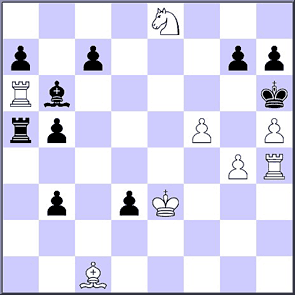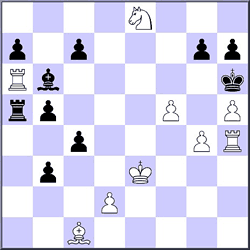



Ultimately chess is just chess – not the best
thing in the world and not the worst thing in
the world, but there is nothing quite like it.
W.C. Fields
For me, chess is mostly an invisible game. Of course, when you go to a chess event and watch two players in play, you see a chessboard, you see pieces on the board, and you see the two opponents alternately moving the pieces. But that's essentially all. You see only the tip of the iceberg. If that were everything that there is to chess, the game would be as interesting as watching grass grow, paint dry, or continents drift. And in fact chess has been compared to all of these things.
The overwhelming part of chess, though, is underneath the surface. First of all, the current landscape of pieces on the board merely keeps track of the distribution of forces over the chess universe of those 64 squares, it's sort of a book-keeping device. What counts, however, and what's decisive is what both players are able to do with these forces. And to see what they are able to do, they have to mentally travel several steps further down the game tree and evaluate the ensuing position in terms of strengths and weaknesses, then integrate all of these into an overall assessment. All this concerns the fine structure of the sequence of positions that may develop from the board position in 1, 2, 3, … single moves, an invisible virtual reality unfolding in the minds of both players. There is a plethora of move consideration, pattern formation, position evaluation going on at high speed inside the players heads. This comprises the invisible intellectual side of chess.
But every chess player knows that there is also a massive emotional side to chess. Recently, a team of psychologists from Seattle Pacific University (USA) led by Professor Jeffrey A. Joireman conducted a most interesting study on this subject, titled “Sensation Seeking and Involvement in Chess” [Joireman, J.A., Fick, C.S., Anderson, J.W. (2002) published in Personality and Individual Differences, 32, 509-515].
The team discovered that enthusiastic chess players score very highly on psychological
tests designed to measure sensation seeking, which is “a trait defined
by the seeking of varied, novel, complex, and intense sensations and experiences
and the willingness to take physical, social, legal and financial risks for
the sake of such experiences.”
If you ask non-chess players, they will probably find this somewhat surprising
since usually the list of activities associated with sensation seeking does
not include chess but rather bungee jumping, sky diving, paragliding, scuba
diving and mountaineering.
Furthermore, the group of psychologists found that during a chess game a wealth of intense emotions is experienced by both players, and if they are involved in a tense and important struggle, there is an accompanying testosterone rush, typically of the same order of magnitude as that experienced by people involved in one of those risky undertakings just mentioned.
Hence, intellectually and emotionally there is a lot going on when two people are playing a game of chess, but it's mostly invisible. Even the strong emotions are virtually all internalized. At the end of a game, win or lose or draw, there isn't more than a hand-shake, and that's it.
Just compare this, if you will, to soccer. Hardly anywhere else do you see such strong emotions as after an important goal in an important game. The players almost jump out of their clothes, jump all over each other, nearly squeeze the goal scorer to death. In chess, not more than a subdued hand-shake …
It would be refreshing to see a bit more effervescent emotional intensity in chess events. Take boxing as another example. The two fighters enter the arena to some especially composed music, each one being introduced in detail as they separately make their entrance on stage, both being welcomed by the audience like gladiators. In chess, if you are lucky you got someone who symbolically makes the first move and jointly with the players smiles into a few cameras, a still life. It's a bit meager in comparison. Of course, I do not suggest that for chess events we should adopt the boxing format one-to-one, but I do think that we can learn a bit from them.
Sometimes, chess is even reduced further, to the bare essentials. In the Amber Tournament taking place each year in Monaco and attracting the best players in the world, the participants play half their games blindfold. Another step towards invisibility. Blindfold chess has a tradition almost as long as the game itself. There is even a remark in Bhudda's writings, where he mentions that many monks and ascetics in those days were addicted to “chess in the air”, as he called it.
Chess in the air is almost cristalline in its purity. For a similar view, we quote from Vladimir Nabokov's novel The Defence, where the following is said about its main character Lushin, a chess grandmaster modelled after Akiba Rubinstein:
“He found therein deep enjoyment: one did not have to deal with visible, audible, palpable pieces whose quaint shape and wooden materiality always disturbed him and always seemed to him but the crude, mortal shell of the exquisite, invisible chess forces. When playing blind, he was able to sense these diverse forces in their original purity. He saw then neither the Knight's carved mane nor the glossy heads of the Pawns – but he felt quite clearly that this or that imaginary square was occupied by a definite, concentrated force, so that he envisioned the movement of a piece as a discharge, a shock, a stroke of lightning – and the whole chess field quivered with tension, and over this tension he was sovereign, here gathering in and there releasing electric power.”
The ability to play blindfold chess, i.e. the art of perfect visualization of the position and its analysis is one of the most important ones for being able to play master level chess. And for the world's top players it practically makes only very little difference if they play with or without looking at the board. Take GM Vassily Ivantchuk, for example, who sometimes for long stretches just stares into nowhere, taking note of the board only when a piece changes its place.
To which level of aesthetic mastery the world's top players can take a blindfold game will be demonstrated with the next specimen. The game certainly is right up there with the most beautiful blindfold games ever played. When it was finished, Kramnik – the winner – was heard to murmur several times: ”Such a beauty. Such a beauty.” And it certainly is. It contains several unusual, even paradoxical aspects. A king which in the middle of the game walks across the entire board into enemy territory and thus becomes decisive for White. This is very rarely seen in super-grandmasterdom since this sort of conduct is prototypically accompanied by loss of the game for the wandering king. Towards the end, Topalov – playing black – had a lead in material, his king had the space and the time, but it was impossible for him to prevent a mate that was appearing at the horizon.
We only give the moves here and invite you to visualize the game from the beginning just as the players did. Make sure you have about an uninterrupted hour for yourself in quiet concentration. Perhaps make yourself comfortable in your favourite chair, looking out into the sky, having something to drink within easy reach. Then after Black's 31st move try to find the fantastic combination that ends the game. But do so without looking at the diagram. You still have an advantage in that you know that there is a combination lurking in the position. If you do not succeed, study the diagram and try again. Carry the position along in your head as you go about your business again. Have your subconscious work on it. If you still don't succeed, there is always next month when the solution will be given in the September column.
Kramnik – Topalov, Monaco 2003 (blindfold)
1. e4 c5 2. Nf3 e6 3. d4 cxd4 4. Nxd4 Nc6 5. Nc3 d6 6. Be3 Nf6 7. f4
a6 8. Qf3 Qc7 9. 0-0-0 Bd7 10. Nb3 Rc8 11. Kb1 b5 12. Bd3 Nb4 13. g4 Bc6 14.
g5 Nd7 15. Qf2 g6 16. Rhf1 Bg7 17. f5 Ne5 18. Bb6 Qd7 19. Be2 Qb7 20. Na5 Qb8
21. f6 Bf8 22. a3 Nxc2 23. Kxc2 Bxe4+ 24. Kb3 Ba8 25. Ba7 Qc7 26. Qb6 Qxb6 27.
Bxb6 h6 28. Nxb5 Kd7 29. Bd4 Bd5+ 30. Ka4 axb5+ 31. Bxb5+ Bc6

Position after 31…Bc6
Did you sense the beauty that transpires from the manoeuvres on the board? The German artist Ugo Dossi has invented a visual way to capture a chess game as a whole, thus making part of its beauty visible. A color is assigned to every chess piece. Each of its moves is represented by the corresponding trajectory which begins and ends with the piece's assigned color and runs through the entire spectrum of colors. In Ugo Dossi's splendid world of colored trajectories, the Kramnik-Topalov blindfold game is visualized like this:

Ugo Dossi: Trajectories of a chess game
Kramnik-Topalov 2003 (blindfold)
This was the problem, constituting in fact three problems in one:
Vasilenko and Frolkin, 1995

White mates in 2 moves
(a) Diagram
(b) After the first two half moves
(c) Before the last two half moves
Let us first of all note that the above position is legal. It's easy to prove that the last moves are given by –1…c4xd3 e.p.+ –2. d2-d4 c5-c4+. The solution to part (a), the mate in two moves from the above diagram, is 1. Kxd3+ g5 2. hxg6 e.p. mate.
Now consider the position resulting from the diagram after 1.Kxd3+ g5 has been played. This is the starting position for part (b) of the problem.

(b) White mates in 2 moves
It is important to note that in this position the en passant capture 1.hxg6 e.p. is not legal since it cannot be proved that the last move must have been g5. There are other last moves that could have generated the above position. The mate in two is given by 1.Bb2 gxh4. After any other black reply there is 2.Bg7 mate. But after the text move 2.Bc1 gives mate.
Rewinding from the original diagram by –1…c4xd3 e.p.+ –2. d2-d4 one arrives at the following position which is the starting point for part (c):

(c) White mates in 2 moves
Here the solution is given by 1.Kf4 g5+ (otherwise 2. g5 mate) 2. hxg6 e.p. mate.
 About
the author
About
the authorChristian Hesse holds a Ph.D. from Harvard University and was on the faculty of the University of California at Berkeley until 1991. Since then he is Professor of Mathematics at the University of Stuttgart (Germany). Subsequently he has been a visiting researcher and invited lecturer at universities around the world, ranging from the Australian National University, Canberra, to the University of Concepcion, Chile. Recently he authored “Expeditionen in die Schachwelt” (Expeditions into the world of chess, ISBN 3-935748-14-0), a collection of about 100 essays that the Viennese newspaper Der Standard called “one of the most intellectually scintillating and recommendable books on chess ever written.”
Christian Hesse is married, has a six-year-old daughter and a two-year-old son. He lives in Mannheim and likes Voltaire's reply to the complaint: ”Life is hard” – “Compared to what?”.
Previous article: